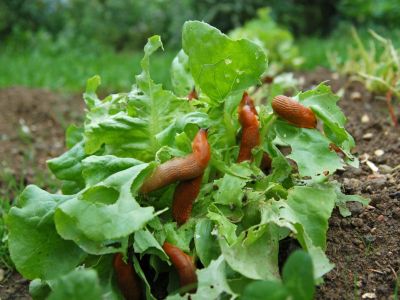Most Common Pests of the Northwest
Arguably, the most common Pacific Northwest pests are slugs and snails. These terrestrial gastropods can wreak havoc in the garden, especially around tender new plants. Cool, overcast, and rainy weather bring out these mollusks to feed on leaves. Irregular holes found anywhere on the leaf are a sure sign of these northwestern garden pests, but a telltale trace of slime will be the main clue if unsure. Slug frass may also be evident– slug poop that looks like a small, wet, green/brown pellet. If there is any doubt that you are dealing with slugs or snails, look under leaves and around the damaged plant and its likely you will find the culprit(s). Once you’ve discovered that the damage is caused by this pest, what can you do to eradicate them? Slugs feed either in the evening or early morning when the sun won’t dry them out. You can go out to the garden in the evening with a flashlight and handpick them from the plants. Drop them in a bucket of soapy water to kill them. If handpicking makes you squeamish, lay a board out in the garden. In the late morning when the sun is rising, flip the board over and you will be rewarded with a slew of slugs that can be disposed of easily. Additionally, Sluggo is a pesticide that targets slugs and snails. It is organically approved and kills only slugs and snails, not other beneficial insects.
Additional Northwestern Garden Pests
While slugs and snails are predominant pests of the Northwest, they are by no means the only ones. We avoid squash vine borers and tomato hornworms in this region, but we also get tons of earwigs, pillbugs, and black vine weevils. So many that it isn’t unusual to spot them indoors as well. Earwigs are slender, reddish brown insects that have tails that end in pincers. While this pest can’t harm people, it can wreak havoc in the garden. Another nocturnal pest, it chews on tender leaves of plants running the range from flowers to fruit and produce. Like slugs, it is attracted to moist, dark places. More of a nuisance than anything else, the pillbug isn’t actually an insect but is related to lobsters and crabs. Like their crustacean cousins, the pillbug has an exoskeleton composed of hard armored plates. It lives on land but actually breathes through gills. It usually eats dead plant material but isn’t above munching on seedlings or tender fruits and vegetables. The black vine weevil is brown to black in color with a long and curved downward snout. Another nocturnal pest of the northwest, it feeds on a wide array of plants although it has its preferences. Larvae of this weevil feed on plant roots, which can kill the plant. Lest you think that the Pacific Northwest gardener is getting off easy, a partial list of additional pests found in this region includes:
AphidBark beetleCaterpillarCricketCutwormGrasshopperLeaf beetleLeafhopperLeafminerLeafrollerMealy bugPsyllaRoot weevilSawflyScaleSpider miteSpittlebugStinkbugThripsWhiteflyWoodborer
Pest Control in the Pacific Northwest
In most instances of pest infestation, healthy plants fare better. Keep plants consistently watered and fertilized, allow for aeration by keeping plants apart, clean up any plant detritus, and weed around plants. Good sanitation and a lack of stress go a long way in pest control, but sometimes a more direct method of control is necessary. Hand picking is always one way to go, as are traps. In the case of earwigs, trap these Northwest pests by putting newspaper in the planting bed. Earwigs will think it’s a hotel meant for them and they can be tidily wrapped up with the news in the morning. The newspaper insect inn also works with pillbugs, or you can surround affected plants with black plastic which gets too hot for these crustaceans to walk on. Weevil larvae can be killed off by decreasing the amount of irrigation. Adult weevils can be handpicked and dumped into a bucket of sudsy water. Of course, there are always insecticides, such as neem oil. A bit of liquid dish soap in a sprayer with water will deter some pests, such as aphids. Also, try encouraging or introducing beneficial insects or even chickens and ducks to the landscape to eat the insect predators.
